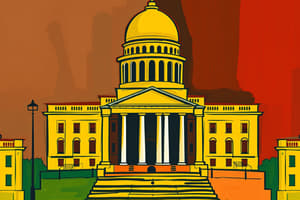Podcast
Questions and Answers
Who plays a pivotal role in setting governmental priorities and allocating resources?
Who plays a pivotal role in setting governmental priorities and allocating resources?
What is the key role of the cabinet in the executive branch?
What is the key role of the cabinet in the executive branch?
What is the principle that guides decision making within the cabinet?
What is the principle that guides decision making within the cabinet?
Who oversees the executive branch and represents the country both domestically and internationally?
Who oversees the executive branch and represents the country both domestically and internationally?
Signup and view all the answers
What is the process of working towards achieving general agreement within a group called?
What is the process of working towards achieving general agreement within a group called?
Signup and view all the answers
Which group collaborates to ensure that government policies align with their political agenda and public expectations?
Which group collaborates to ensure that government policies align with their political agenda and public expectations?
Signup and view all the answers
Study Notes
The Executive Branch Role
- Implements laws and policies, and directs the bureaucracy that administers government programs and services
- Plays a pivotal role in policy making, setting governmental priorities, and allocating resources
The Prime Minister and Cabinet Roles
- The Prime Minister (PM) sets the tone for public policy, oversees the executive branch, and represents the country both domestically and internationally
- The Cabinet, consisting of ministers who head various government departments, collaborates to formulate and implement government policies
- Ensures that policies align with their political agenda and public expectations
Cabinet Decision Making
- Involves collective discussion and consensus-building among ministers
- Guided by the principle of collective responsibility, meaning that decisions are made collectively and publicly supported by all cabinet members
- Ensures a unified front and shared accountability for government decisions, even if there was disagreement in the decision-making process
Studying That Suits You
Use AI to generate personalized quizzes and flashcards to suit your learning preferences.
Description
Explore the role of the executive branch in public administration, focusing on the Prime Minister and Cabinet's responsibilities in policy making, resource allocation, and directing governmental priorities.



